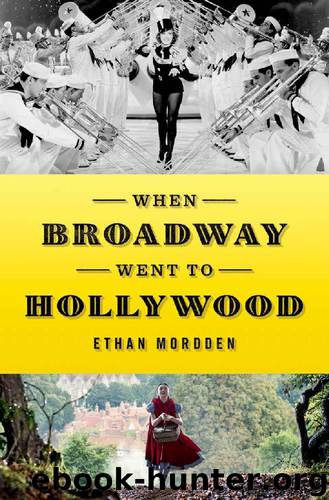When Broadway Went to Hollywood by Ethan Mordden

Author:Ethan Mordden [Mordden, Ethan]
Language: eng
Format: epub
ISBN: 9780199395408
Publisher: Oxford University Press
Published: 2016-11-01T04:00:00+00:00
As well, we have director Minnelli’s famous fashion sense, which moves the somewhat campy doings into the realm of the fabtastic. When Garland first meets Kelly, she is wearing the biggest and most bizarre snood in history. Even the sight of her, in her first shot, wearing a cross around her neck is startling. Yes, it’s contextually correct for a young girl living a sheltered life in a Christian community. But it comes off as not a spiritual comfort but a bauble, even a minor blasphemy as a sample of Minnelli’s binge accessorizing. When Kelly shows up sporting biceps rings, we wonder if this is The Pirate or Rough Trade of the Caribbean.
True, that only makes the film all the more entrancing. But Porter lets us down, with perfunctory ballads and plot numbers that do the job on site but are not worth rehearing (except for the ebullient “Be a Clown”). This was the height of the Porter slump; after a hit stay at Radio City Music Hall, The Pirate flopped badly, too flamboyant for the second and third audiences.
Only the arrival on Broadway of the smash Kiss Me, Kate reinstalled Porter as a Broadway champ. The following Out Of This World and Can-Can had wonderful scores but book problems (though Can-Can was a huge hit), and Porter’s next new Hollywood work, MGM’s High Society (1956), was second-division Porter. It hit his characteristic points—the Latin rhythm number in “Mind If I Make Love To You,” the charm song full of syncopation and “wrong” notes in “You’re Sensational.” Porter even turned himself inside out in two numbers for Louis Armstrong, “High Society Calypso” (the Afro-Caribbean anticipation of reggae had just begun to trend in America) and, in duet with Bing Crosby, “Now You Has Jazz.” And the film’s hit, “True Love,” is a waltz so simple neither the vocal nor the chorus has any syncopation whatever. This is smooth Porter, the Tin Pan Alley Porter who wants everyone to like him, even the tourists.
Everything about High Society is smooth—to a fault. Armstrong gives it flair, but everyone else is so relaxed he or she might be bantering between acts on a telethon. These are pale replicas of the characters so memorably portrayed in MGM’s first go at this material, The Philadelphia Story, especially by Katharine Hepburn and Cary Grant. In their first moment, the two are in mid-fight; she breaks his golf clubs and he starts to take a swing at her, recalls himself to manly grace, and simply shoves her self-satisfied mug out of shot.
This is not tough love. It’s real anger, and while Philip Barry, who wrote the Broadway Philadelphia Story, is remembered only as a boulevardier, he was in fact a deeply religious writer who interspersed romantic comedies with allegories on the human condition, much as Cole Porter moved between popular and elite composition. Underneath Barry’s Society folderol, provocative relationships undergo scrutiny as if in Christian parable; his characters are likable but worrisome—and, from First Couple Bing Crosby and Grace Kelly on down, there is nothing worrisome in this High Society.
Download
This site does not store any files on its server. We only index and link to content provided by other sites. Please contact the content providers to delete copyright contents if any and email us, we'll remove relevant links or contents immediately.
The Goal (Off-Campus #4) by Elle Kennedy(12429)
Kathy Andrews Collection by Kathy Andrews(10517)
Diary of a Player by Brad Paisley(6866)
What Does This Button Do? by Bruce Dickinson(5525)
Assassin’s Fate by Robin Hobb(5236)
Big Little Lies by Liane Moriarty(4879)
Pale Blue Dot by Carl Sagan(4001)
Sticky Fingers by Joe Hagan(3454)
The Heroin Diaries by Nikki Sixx(2930)
The Death of the Heart by Elizabeth Bowen(2901)
Beneath These Shadows by Meghan March(2718)
The Help by Kathryn Stockett(2702)
Confessions of a Video Vixen by Karrine Steffans(2672)
How Music Works by David Byrne(2524)
Jam by Jam (epub)(2486)
Harry Potter 4 - Harry Potter and The Goblet of Fire by J.K.Rowling(2416)
Strange Fascination: David Bowie: The Definitive Story by David Buckley(2367)
Petty: The Biography by Warren Zanes(2237)
Darker Than the Deepest Sea by Trevor Dann(2206)
